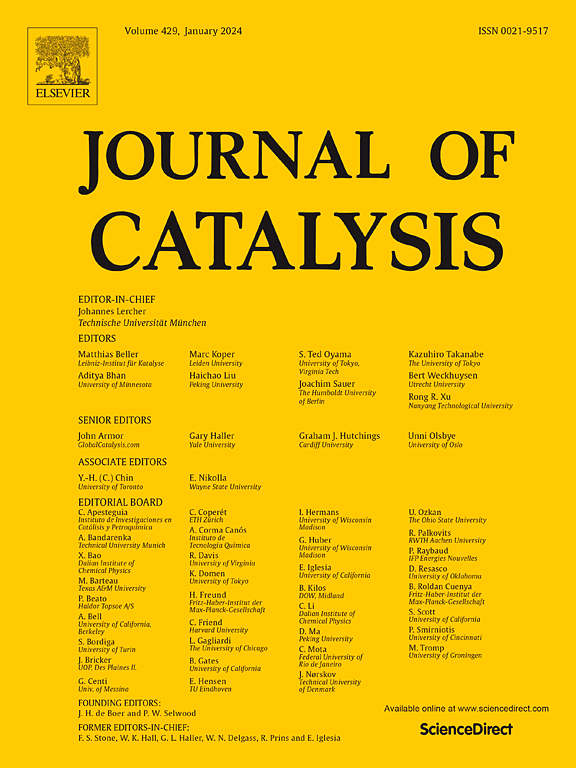Design targeted high entropy sulfides catalysts for OER by theoretical predictions
IF 6.5
1区 化学
Q2 CHEMISTRY, PHYSICAL
引用次数: 0
Abstract
Currently, using Density Functional Theory (DFT) to drive the synthesis of targeted oxygen evolution reaction (OER) catalysts, has attracted strong attention. Herein, sulfides were selected as the models. First, the density of states (DOS), active sites and the Gibbs free energy of intermediates (ΔG) of different models were calculated respectively. DFT results indicated that d-band centers of models with sulfur vacancies, self-reconstruction, or high entropy structures possessing lower ΔGmax, being closer to the Fermi level, exhibiting higher DOS at the Fermi level. To verify DFT results, thiourea was used as a precursor to prepare (CrMnCoNiMo)0.2Sx for the first time. Indeed, (CrMnCoNiMo)0.2Sx exhibited excellent OER activity (η100 = 266 mV, Tafel slope = 57.4 mV dec−1) and strong catalytic stability. The sulfur vacancies were confirmed by EPR experiments. TEM, XPS and ICP-AES all confirmed the leaching of Cr and Mo elements after OER. XPS, TEM and In situ Raman confirmed the self-reconstruction of (CrMnCoNiMo)0.2Sx during the OER. The above experimental results perfectly confirmed the initial DFT calculation.


根据理论预测设计目标高熵硫化物OER催化剂
目前,利用密度泛函理论(DFT)驱动定向析氧反应(OER)催化剂的合成受到了广泛关注。本文选择硫化物作为模型。首先,分别计算了不同模型中间产物的态密度(DOS)、活性位和吉布斯自由能(ΔG)。DFT结果表明,具有硫空位、自重构或高熵结构的模型的d带中心具有更低的ΔGmax,更接近费米能级,在费米能级表现出更高的DOS。为了验证DFT结果,首次以硫脲为前驱体制备了(CrMnCoNiMo)0.2Sx。事实上,(CrMnCoNiMo)0.2Sx具有优异的OER活性(η100 = 266 mV, Tafel斜率 = 57.4 mV dec−1)和较强的催化稳定性。通过EPR实验证实了硫空位的存在。TEM、XPS和ICP-AES均证实了OER后Cr、Mo元素的浸出。XPS, TEM和In situ Raman证实了(CrMnCoNiMo)0.2Sx在OER过程中的自重建。上述实验结果很好地证实了初始DFT计算。
本文章由计算机程序翻译,如有差异,请以英文原文为准。
求助全文
约1分钟内获得全文
求助全文
来源期刊

Journal of Catalysis
工程技术-工程:化工
CiteScore
12.30
自引率
5.50%
发文量
447
审稿时长
31 days
期刊介绍:
The Journal of Catalysis publishes scholarly articles on both heterogeneous and homogeneous catalysis, covering a wide range of chemical transformations. These include various types of catalysis, such as those mediated by photons, plasmons, and electrons. The focus of the studies is to understand the relationship between catalytic function and the underlying chemical properties of surfaces and metal complexes.
The articles in the journal offer innovative concepts and explore the synthesis and kinetics of inorganic solids and homogeneous complexes. Furthermore, they discuss spectroscopic techniques for characterizing catalysts, investigate the interaction of probes and reacting species with catalysts, and employ theoretical methods.
The research presented in the journal should have direct relevance to the field of catalytic processes, addressing either fundamental aspects or applications of catalysis.
 求助内容:
求助内容: 应助结果提醒方式:
应助结果提醒方式:


